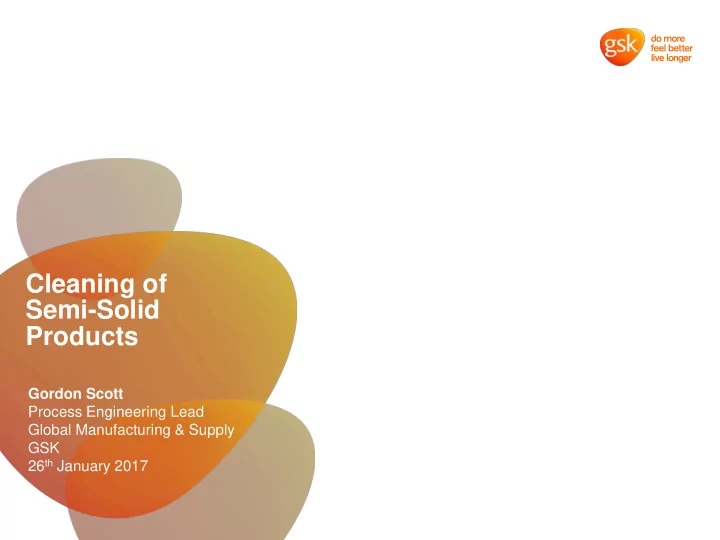

Cleaning of Semi-Solid Products Gordon Scott Process Engineering Lead Global Manufacturing & Supply GSK 26 th January 2017
Definition of Clean Pharmaceutical Industry 1. Visually clean – Free from product / contamination – Determined by staff responsible for equipment cleaning – Verified after every clean Chemically clean – free of API (or selected chemical marker) 2. – Determined by the lab through swabbing – Proven during validation. Periodically re-confirmed as part of validation maintenance Cleaning is therefore the actions required to return a piece of process equipment back to a clean state after manufacture
HoW are you cleaning? – Effective cleaning is the result of cleaning for the right length of Time at the right Temperature using the right Detergent (chemistry) and the right level of Energy (mechanical) – Having this balance wrong will lead to ineffective cleaning cycles or extended cleaning times – The balance of these four factors will be product dependant, hence no one standard cleaning cycle on the manufacturing vessels or washers for all products
Product Overview Dermatological / Skin Health Products Creams Ointments • O/W emulsion • Single phase • Dissolved / dispersed drug active • Petrolatum based • Medium viscosity • Dissolved / dispersed drug active • High viscosity Lotions • O/W emulsion Gels • Dissolved / dispersed drug active • Single phase • Low viscosity • Aqueous based • Dissolved / dispersed drug active • Medium - high viscosity Pharmaceutical products Viscosity • Smaller range of excipients Really interested in rheology • Drug actives • Shear thinning? • Yield? Cosmetic / Consumer products • Wide range of excipients • Etc
Current Position – Manual cleaning – Increasing application of manual inspection of components post cleaning – Wash bays visually clean – Manual preparation for automated – Initial “3 - batch” validation followed by cleaning periodic revalidation chemically clean – Dismantling / initial bulk product removal – Cleaning-In-Place – Cleaning being viewed as another – Integral part of equipment processing step by the regulators. – Dedicated CIP skid Expecting good understanding of critical – House CIP skid cleaning processes – Cleaning-Out-Of place – Parts Washers – Process understanding work with University of Leeds – Typically, cleaning operations are more – Pulling together chemical and mechanical manual than they are automated aspects of cleaning – Supporting operators with basic training on the importance of cleaning
What are you cleaning? – All equipment used in the manufacture and filling of product – Dispensing, bulk manufacture & filling – Focus here is on product contact parts – critical cleaning – Equipment used to clean equipment – Parts washers, CIP systems
Equipment Flow & Cleaning Bulk Manufacture Inspection
Equipment Flow & Cleaning Filling Inspection
Typical Failure Modes – Equipment not visually clean at end of validated wash cycle – Both CIP and COP – Failures associated with residues of final product and components within product (e.g. API enriched in heavy components of white soft paraffin and part hydrated Carbomer gel) – View is that the CIP and COP equipment delivers a repeatable cleaning cycle, though there may be subtle differences that could be driving cleaning failures – Human activities are controlled by procedures (e.g. stacking of wash racks) though there are probably degrees of freedom that have not been tied down sufficiently leading to variability in the input to the cleaning process. This is particularly true for COP
Target – Automated cleaning – Minimised / optimised manual intervention – Manual COP – COP CIP – Automated inspection and release – Fully validated – Optimised cleaning cycles – Detergents / water / heat etc – Underpinned by sound product & process understanding
Areas of Interest Must Drive Understanding and Productivity – Mapping of removal mechanisms – The role that flow, temperature and detergent action have on the removal of products from surfaces) – E.g. removal of hydrophobic materials (e.g. pigments and sunscreens) or polymer-thickened products (e.g. Carbomer gels) – Modelling the cleaning of complex geometries – e.g. sprays & jets used in CIP and COP systems – Optimising cleaning regimes in CIP and COP systems (e.g. parts washers) – Detection methods of visual and chemical contamination on surfaces that can be integrated into CIP and COP systems – Assessment of current cleaning technologies – E.g. sprayball / jet technology selection guides? – Novel cleaning technologies (e.g. ice-pigging, ultrasonics)
Recommend
More recommend